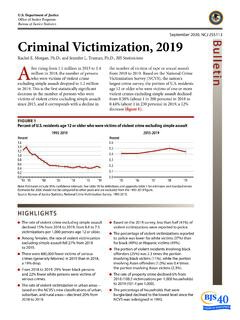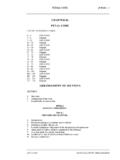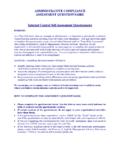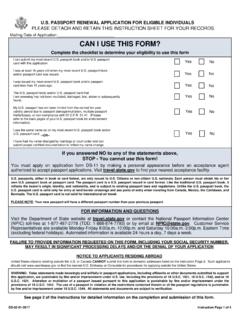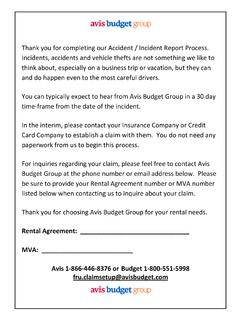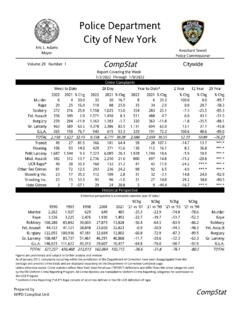Transcription of and Thefts Disasters, - IRS tax forms
1 ContentsWhat s on of a a To Report Gains and Area To Report Gains and To Get Tax s NewLimitation on personal casualty and theft losses. Personal casualty and theft losses of an individual, sustained in a tax year beginning after 2017, are deductible only to the extent they re attributable to a federally declared dis-aster. The loss deduction is subject to the $100 limit per casualty and 10% of your adjusted gross income (AGI) exception to the rule above, limiting the personal casualty and theft loss deduction to losses attributable to a federally declared disas-ter, applies if you have personal casualty gains for the tax year. In this case, you will reduce your personal casualty gains by any casualty losses not attributable to a federally declared disaster.
2 Any excess gain is used to reduce los-ses from a federally declared disaster. The 10% AGI limitation is applied to any remaining losses attributable to a federally declared disaster. For more information, see Disaster Area Losses, adjustment for standard deduction made retroactively inapplicable to net qualified disaster losses. The AMT adjust-ment for the standard deduction doesn t apply to the increase in the standard deduction that is attributable to a net disaster loss. See Taxpay-ers who also file the 2018 form 6251, Alterna-tive Minimum Tax for Individuals in the Instruc-tions for form 4684, Casualties and Thefts , for more miscellaneous itemized deductions al-lowed. You can no longer claim any miscella-neous itemized deductions.
3 Miscellaneous itemized deductions are those deductions that would have been subject to the 2% of AGI Department of the TreasuryInternal Revenue ServicePublication 547 Cat. No. 15090 KCasualties, Disasters, and TheftsFor use in preparing2018 ReturnsGet forms and other information faster and easier at: (English) (Espa ol) ( ) ( ) (Pусский) (Ti ngVi t) Userid: CPMS chema: tipxLeadpct: 100%Pt. size: 8 Draft Ok to PrintAH XSL/XMLF ileid: .. tions/P547/2018/A/XML/Cycle04/source(Ini t. & Date) _____Page 1 of 22 12:30 - 30-Jan-2019 The type and rule above prints on all proofs including departmental reproduction proofs. MUST be removed before 30, 2019limitation. As a result, ordinary losses on non-federally insured deposits in an insolvent or bankrupt financial institution as well as business casualty and theft losses of property used in performing services as an employee can t be deducted.
4 References to these loss deductions have been revised accordingly in this form 1040 redesigned. The 2018 form 1040 has been redesigned and is supplemen-ted with new Schedules 1 through 6. These ad-ditional schedules will be used as needed to complete more complex tax returns. Referen-ces to form 1040 and its related schedules have been revised accordingly in this rules for capital gains invested in Qualified Opportunity Funds. In 2018, if you have a capital gain, you can invest that gain into a Qualified Opportunity Fund and elect to defer part or all of the gain that you would otherwise include in income until December 31, 2026. You also may be able to permanently exclude gain from the sale or exchange of an investment in a Qualified Opportunity Fund if the investment is held for at least 10 years.
5 For information about how to elect to use these special rules, see the Instructions for form 8949, Sales and Other Dispositions of Capital Assets. For additional in-formation, see Opportunity Zones Frequently Asked Questions on of gain invested in a Qualified Opportunity Fund. If you realize a gain from an actual, or deemed, sale or exchange with an unrelated person and during the 180-day period beginning on the date realizing the gain, inves-ted an amount of the gain in a Qualified Oppor-tunity Fund, you may be able to elect to tempo-rarily defer part or all of the gain that would otherwise be included in income. If you make the election, the gain included in taxable in-come is only to the extent, if any, the amount of realized gain exceeds the aggregate amount in-vested in a Qualified Opportunity Fund during the 180-day period beginning on the date realiz-ing to report.
6 Report the gain as it would otherwise be reported if you were not making the election. Report the election for the amount invested in a Qualified Opportunity Fund (Fund) on form 8949. See the Instructions for form 8949 for information on how to make the rules for qualified disaster losses. Personal casualty losses attributable to a major disaster declared by the President under sec-tion 401 of the Robert T. Stafford Disaster Re-lief and Emergency Assistance Act (Stafford Act) in 2016, as well as from Hurricane Harvey, Tropical Storm Harvey, Hurricanes Irma and Maria, and the California wildfires, may be claimed as a qualified disaster loss on your form 4684. You can deduct qualified disaster losses without itemizing other deductions on Schedule A ( form 1040).
7 Moreover, your net casualty loss from these qualified disasters doesn t need to exceed 10% of your adjusted gross income to qualify for the deduction, but the $100 limit per casualty is increased to $ Disaster Area Losses for more informa-tion on the special relief provided as part of the Disaster Tax Relief and Airport and Airway Ex-tension Act of 2017, the Tax Cuts and Jobs Act of 2017, and the Bipartisan Budget Act of 2018. Also see Pub. 976, Disaster Relief, and for more information about these and other disaster tax relief the time this publication went to print, Congress was considering legis-lation that would provide additional tax relief for those affected by 2018 disasters, such as Hurricane Florence.
8 To learn whether this legislation was enacted, go to Recent Develop-ments at developments. For the latest informa-tion about developments related to Pub. 547, such as legislation enacted after it was pub-lished, go to of missing children. The Inter-nal Revenue Service is a proud partner with the National Center for Missing & Exploited Children (NCMEC). Photographs of missing children selected by the Center may appear in this publication on pages that would otherwise be blank. You can help bring these children home by looking at the photographs and calling 1-800-THE-LOST (1-800-843-5678) if you rec-ognize a publication explains the tax treatment of casualties, Thefts , and losses on deposits.
9 A casualty occurs when your property is damaged as a result of a disaster such as a storm, fire, car accident, or similar event. A theft occurs when someone steals your property. A loss on deposits occurs when your financial institution becomes insolvent or publication discusses the following top-ics. Definitions of a casualty, theft , and loss on deposits. How to figure the amount of your gain or loss. How to treat insurance and other reim-bursements you receive. The deduction limits. When and how to report a casualty or theft . The special rules for disaster area to file. Generally, when you have a casualty or theft , you have to file form 4684. You also may have to file one or more of the fol-lowing forms .
10 Schedule A ( form 1040). form 1040NR, Schedule A (for nonresi-dent aliens). Schedule D. form details on which form to use, see How To Report Gains and Losses, For information on condem-nations of property, see Involuntary Conver-sions in chapter 1 of Pub. 544, Sales and Other Dispositions of !Workbooks for casualties and Thefts . Pub. 584, Casualty, Disaster, and theft Loss Work-book (Personal-Use Property), is available to help you make a list of your stolen or damaged personal-use property and figure your loss. It in-cludes schedules to help you figure the loss on your home and its contents, and your motor 584-B, Business Casualty, Disaster, and theft Loss Workbook, is available to help you make a list of your stolen or damaged busi-ness or income-producing property and figure your and suggestions.











